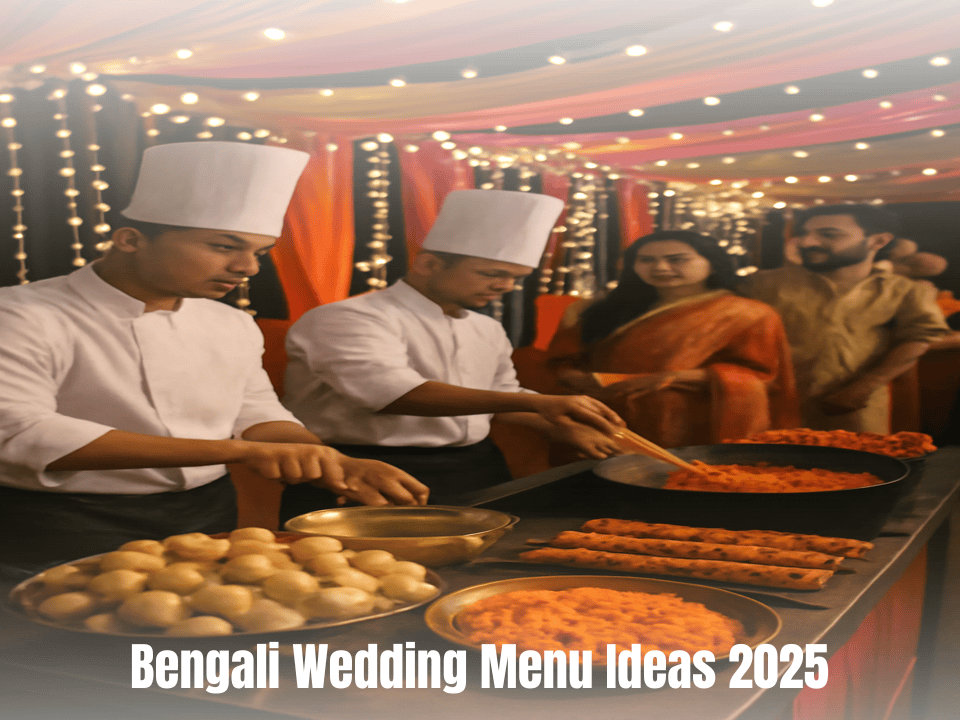
Introduction to Bengali Weddings and Their Culinary Grandeur
Bengali weddings are big, emotional, and all-encompassing events that go beyond the ceremonies themselves. They are the perfect mix of culture, color, laughter, music, and, of course, food that you will never forget. People often remember the rich, tasty food from a Bengali wedding the most when they think back on it. The Bengali wedding menu is more than just a list of foods. It shows off the culture by using traditional foods, seasonal produce, and foods that have been passed down through generations.
Table of Contents
ToggleFood is always the most important part of a wedding, whether it’s a big one in the middle of Kolkata or a small one in another city or country. Every dish at a Bengali wedding, from the welcome drinks and appetizers to the main courses and desserts, is planned out in advance. The food spread at a Bengali wedding is often what makes it different from other weddings. It’s a way to show hospitality, celebrate, and be proud.
A real Bengali wedding menu has several courses, which usually include fish, meat, vegetarian dishes, rice dishes, fried snacks, and an amazing range of sweets. There are even interesting differences between regions in the same state. A Ghoti (from West Bengal) wedding menu might be different from a Bangal (from East Bengal) one. For example, the fish, spices, and even the way the rice is cooked might be different.
A lot of the time, modern Bengali weddings mix tradition with new ideas. Along with classic dishes like Shorshe Ilish, Kosha Mangsho, and Mishti Doi, today’s wedding menus might include live food counters, fusion starters, and interactive dessert tables. The Bengali wedding menu is planned based on how guests’ tastes change, what ingredients are available, and what’s popular in the kitchen.
This guide will show you all the tasty details, from traditional dishes that are based on heritage to modern options that will please a wide range of tastes. This is the place to go if you’re a couple planning your wedding, a caterer making a custom menu, or just someone who loves Bengali food. This is the best guide for planning the perfect Bengali wedding menu that people will remember for years to come. It focuses on tradition, innovation, and making guests happy.
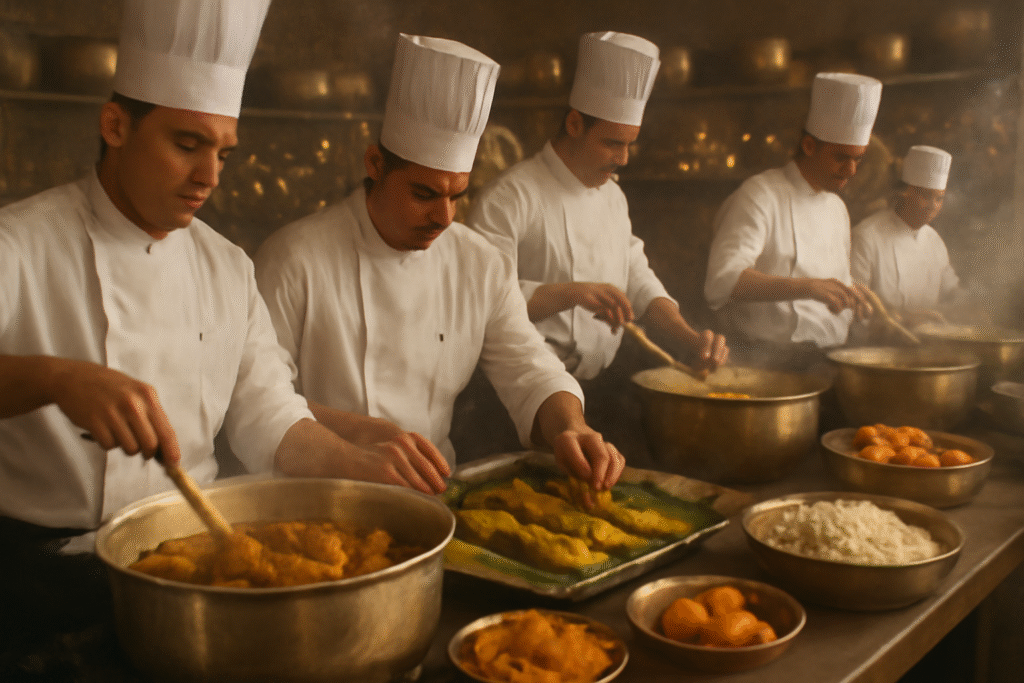
Cultural Significance of Bengali Wedding Food
Food has always been a big part of Bengali culture, and weddings are the best example of this. In Bengal, cooking is an art, eating is a big deal, and giving food to others is a sacred duty. The Bengali wedding menu is at the center of every Bengali wedding. It is a carefully chosen selection of dishes that tells a story of heritage, hospitality, and heartfelt celebration.
Food-Based Rituals
There are certain food rituals that go along with each part of a Bengali wedding. Aiburobhaat is a meal that includes the bride or groom’s favorite foods, which are often served on banana leaves by the older members of the family. During Gaye Holud, which is the turmeric ceremony, only light and vegetarian foods are served to keep things good. The big meat and fish dishes don’t come out until after the wedding, especially at the bou-bhaat (the groom’s family’s reception).
The menus for all of these events are carefully planned to follow religious, cultural, and seasonal rules. A winter wedding might have hot luchi and kosha mangsho, while a monsoon wedding might have Shorshe Ilish or Chingri Malai Curry.
Meeting the Needs of Guests
Food in Bengal isn’t just for the family; it’s for everyone in the community. There are usually hundreds of people at a wedding, and they all want to have a real, memorable meal. People will talk about a poorly designed Bengali wedding menu for the rest of their lives. Yes, food memories last that long!
So, families spend a lot of time and money putting together great ideas for their wedding menus. Guests will leave both full and impressed if the menu has the right mix of vegetarian and non-vegetarian dishes, crowd-pleasing sweets, and show-stopping dishes like Bhetki Paturi.
Differences by region and religion
There are differences even within Bengal. Bengali weddings in the east may prefer hilsa (ilish), while those in the west may prefer bhetki or mutton. Some families only serve vegetarian food on the main wedding day and save the meat feast for the reception. Some people serve seafood and meat at all of their events.
Hindu Bengali weddings are lucky when they have sweets like Rasgulla and Mishti Doi. Along with traditional Bengali sweets, you might see biryani, rezala, and firni at a Muslim Bengali wedding.
Knowing these little things will help the Bengali wedding food spread honor traditions while also being tasty.
Traditional Bengali Wedding Menu Explained
Bengalis are very serious about food at weddings. A Bengali wedding menu isn’t just a list of favorite foods; it’s a cultural tradition that stands for love, family, and celebration. The variety and depth of the food at a Bengali wedding is what makes it special. Each dish is carefully chosen, often with input from several generations of the family, to make the meal healthy, balanced, and luxurious.
Let’s go through a traditional Bengali wedding menu, from the welcome drinks to the desserts.
1.Differences by region and religion
Before guests even touch the food, they are given traditional drinks. These drinks are refreshing, calming, and great for getting into the mood.
Some popular choices are:
- Aam Pora Sharbat is roasted raw mango with a little bit of cumin and rock salt.
- Gondhoraj Lebu Soda is a fragrant lime soda made with the Gondhoraj lemon, which is only found in Bengal.
- Bel Pana is a sweet drink made from wood apples that is perfect for summer weddings.
- Sweet or salted lassi is a great drink for daytime weddings.
These drinks not only greet guests, but they also show how much the host cares about hospitality, which is a big part of the Bengali wedding food experience.
2. Starters & Appetizers: A Crunchy Welcome
Appetizers are meant to get your taste buds going and make you look forward to the big meal. There are both vegetarian and non-vegetarian options in this course.
Non-Vegetarian Favorites:
- Fish Fry—Kolkata-style battered bhetki fillets that are deep-fried until they are golden brown and served with mustard sauce (kasundi).
- Mutton Chop: Deep-fried minced mutton cutlets covered in breadcrumbs. They are usually served with green chutney.
- Chicken Kabiraji is a crunchy chicken cutlet wrapped in an egg net. It comes from the British era.
Vegetarian Snacks:
- Beguni are thin slices of eggplant dipped in besan batter and fried.
- Mochar Chop: Patties made from banana flowers and traditional spices that are shallow fried.
- Paneer Tikka (Bengali Style) is grilled cubes of paneer that have been marinated in mustard and yogurt.
These dishes set the mood for the meal and are often served at live counters to make it feel even more special.
3. Main Course: The Feast's Heart
This is where the Bengali wedding menu comes alive. The variety is dazzling, often comprising multiple rice dishes, curries, lentils, and both vegetarian and non-vegetarian options.
Rice & Pulao:
- Steamed Gobindobhog Rice is short-grain, fragrant rice that goes great with rich curries.
- Basanti Pulao is a mildly sweet saffron rice dish with cashews and raisins that is often cooked in ghee.
- Fried Rice or Peas Pulao: A new twist that is more common at fusion weddings.
Vegetarian Essentials:
- Shukto is a stew of vegetables that tastes sweet and sour because of the radhuni and mustard paste.
- Cholar Dal is Bengal gram cooked with pieces of coconut and whole garam masala.
- Aloo Posto is a must-have for many people. It is potatoes in poppy seed paste.
- Enchorer Dalna is a jackfruit curry that feels like meat and is often called “vegetarian mutton.”
These vegetarian foods are good for you and are usually served first at traditional weddings.
Non-Vegetarian Royalty:
Fish and meat dishes are the real stars of Bengali wedding food.
- Shorshe Ilish is hilsa fish cooked in mustard paste and mustard oil. It tastes best with plain rice.
- Bhetki Paturi is fish that has been marinated, wrapped in banana leaves, and steamed.
- Chingri Malai Curry is a rich, lightly spiced dish with prawns in coconut milk gravy.
- Kosha Mangsho is a deep, spicy curry made with goat meat that has been slow-cooked.
- Murgir Jhol is a simple Bengali chicken curry that people usually like.
After the vegetarian part of the meal, which is common at many Bengali weddings, these dishes are usually served.
4. Accompaniments: Enhancing the Meal
No Bengali meal is complete without the extras that make it whole.
- Papad: fried or roasted.
- Pickles: mango or tamarind made at home.
- Salad: carrot sticks, cucumber, and onion.
- Lebu-Lonka: Add lime and green chili to make the flavors stronger.
- Kasundi is a spicy mustard relish that is only found in Bengali food.
These sides add texture and contrast, making the whole Bengali wedding menu better.
5. Dessert: The Sweetest Chapter
The dessert spread is the last part of the feast and the one that people talk about the most. Bengali weddings are famous for their many kinds of sweets, some of which are made fresh just a few hours before they are served.
- Rasgulla is a traditional food that is spongy cheese balls soaked in sugar syrup.
- Sandesh is a sweet treat made with fresh chhena and sugar. It comes in many flavors, such as nolen gur, mango, and saffron.
- Mishti Doi is sweet yogurt that has been fermented in clay pots. It is creamy, rich, and naturally cold.
- Langcha is a type of khoya roll that is deep-fried and then dipped in syrup.
- Kamala Bhog is a unique touch: rasgullas with an orange flavor.
- Kheer Kadamba is a sweet with two layers, a creamy filling, and a sandesh shell.
New things:
- Ice cream or kulfi stations
- Gurer Payesh is a rice pudding made with date palm jaggery that is served at winter weddings.
- Sandesh Tiramisu or Mishti Doi Cheesecake are two types of fusion sweets.
Dessert stations at Bengali weddings are often crowded because there are so many sweet options.
Final Thoughts
A traditional Bengali wedding menu is like a royal feast. It makes people happy, respects traditions, and balances flavors, one dish at a time. Guests will always remember the love, care, and variety that goes into each dish, whether you stick to the traditional recipe or add your own modern touches.
Now that you know the main parts of a traditional Bengali wedding menu, you can make a meal that honors tradition while also being modern.
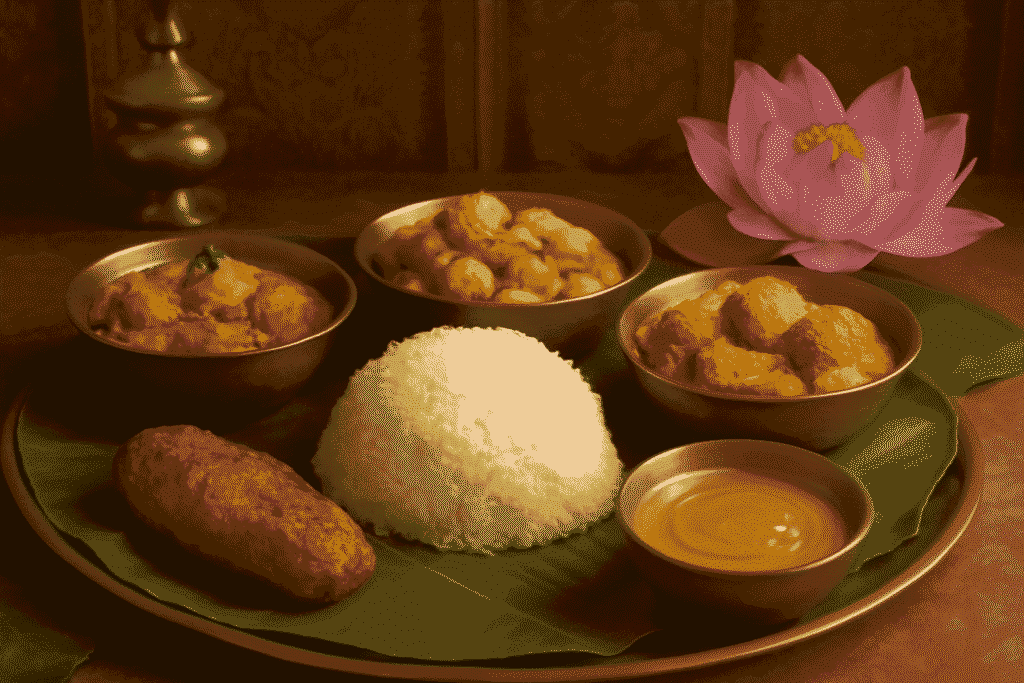
Modern Takes & Regional Variations in the Bengali Wedding Menu
The menu for a traditional Bengali wedding changes as the world does. Many families still stick to traditional foods and customs, but Bengali weddings today are more creative, open-minded, and experimental. The modern Bengali wedding food scene is full of new ideas, from regional flavors to global fusion. Couples are now using their heritage and creativity to make menus that show off both their roots and their personalities.
Let’s look at how modern trends and the fact that people from different parts of the world are getting married are changing the Bengali marriage menu to make it more exciting and fun.
New Trends in Bengali Wedding Food
1. Chef Stations and Live Food Counters
Live counters are now the main attraction at Bengali weddings. Think about how nice it would be to have your guests served hot Fish Fry right off the tawa or Mishti Doi that was made right in front of them. This not only makes things more interactive, but it also keeps food fresh and tasty.
Some of the most popular live stations are:
- Kathi Roll counters
- The Mishti Doi Sundae Bar
- Bengali-style chaat station
- Pithe counters made to order for winter weddings
2. Flavors that mix
People still love classic dishes like Shorshe Ilish and Kosha Mangsho, but many weddings now serve fusion dishes like:
- Tiramisu Sandesh
- Pulao with Paneer Butter Masala
- Pineapple Raita and Mutton Biryani
- Chicken Wings with Kasundi
- Couples can serve younger guests or friends from other areas with fusion dishes that don’t lose their Bengali identity.
3. New International Foods
Some couples have a section for world cuisine next to the Bengali menu. This includes Thai curries, Chinese stir-fry, and Italian pastas. The most important thing is balance. The Bengali wedding menu usually goes well with global cuisine, not the other way around.
Regional Differences Across Bengal
The Bengali community is very different, and Ghotis (native West Bengalis) and Bangals (families from East Bengal, now Bangladesh) have very different eating habits. The Bengali wedding menu makes these differences very clear.
Ghoti Menu Highlights:
- Likes spices that are sweet and mild
- Bhetki Paturi, Basanti Pulao, Cholar Dal, and Chicken Dak Bangla are more common.
- Langcha and Rasgulla are the most popular desserts.
Bangal Menu Highlights:
- Mustard and chili make the flavors stronger.
- Shorshe Ilish, Kosha Mangsho, and Shutki Maachh (dry fish) are some of the most popular dishes.
- Usually has deep-fried hilsa, more curries made with mustard oil, and spicy chingri (prawn) dishes.
A dual-style menu is often made when a couple comes from both sides. It has a mix of Bangal and Ghoti dishes, which is a real celebration of love through food.
Modern Wedding Menu Ideas (Keeping Tradition Alive)
Couples today are combining modern and traditional styles to make sure that all of their guests are happy. Here are some popular wedding menu ideas that are modern but still true to their roots:
Gondhoraj Lemon Risotto: A spicy version of pulao with a lemony smell.
Mutton Pot Pie: A mix of British and Bengali foods, with kosha mangsho wrapped in buttery pastry.
Vegetarian Ilish (Mock Fish Curry): For guests who don’t want the fish but still want the taste.
Chhanar Cheesecake is a mix of traditional chhena sweets and the method of baking cheesecake.
A live Puchka Bar with flavored water is a new favorite at most Bengali weddings in cities.
By adding these choices, hosts make sure that the food at the Bengali wedding feels modern while still being nostalgic.
Aesthetic Presentation Matters
Couples today are very interested in how food is served. A lot of modern Bengali weddings have:
- Food stalls with themes, like “Pithe Parlor” and “Royal Bengal Biryani Corner”
- Brass and clay serving dishes will give your food a vintage Bengali look.
- Custom menu boards that show all the items in English and Bengali
This not only makes the wedding more Instagrammable, which is an unexpected but very real part of modern wedding planning, but it also makes the guest experience better.
Final Note
Tradition is still at the heart of a Bengali wedding menu, but that doesn’t mean it can’t change. Modern weddings let you personalize things like never before. You can serve Bengali wedding food that honors your grandmother’s recipes or fusion dishes that will wow your friends.
Because of this, the Bengali wedding menu of today can be both classic and modern. That balance is what makes a wedding truly memorable.
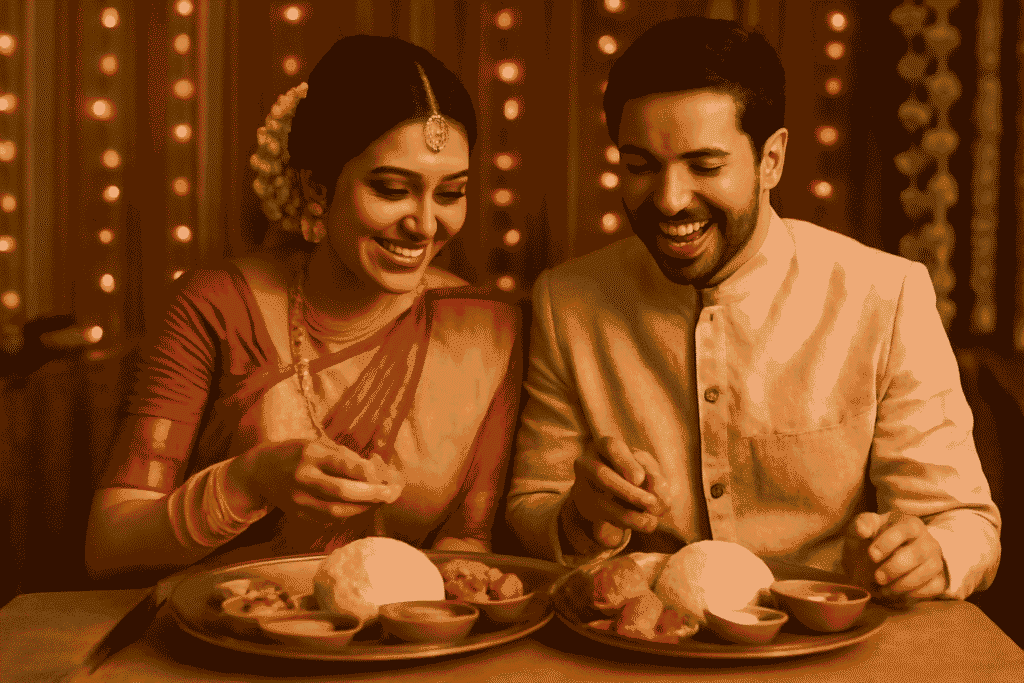
Sample Bengali Wedding Menu Table with Variations & Courses
It’s not enough to just list the dishes when planning the perfect Bengali wedding menu. It’s about putting together an experience across several courses, from appetizers to main courses to sides and desserts, while taking into account tradition, taste, dietary needs, and presentation. Your Bengali wedding food should show off your culture and make people feel welcome, whether it’s a traditional, modern, vegetarian, or fancy event with more than 200 guests.
This is a full breakdown of what an ideal Bengali wedding menu could look like, with options for different occasions, tastes, and guest expectations.
Why a structured menu is important
A well-organized wedding menu ensures:
Smooth serving (especially for buffet or sit-down styles)
A balanced flavor journey from mild to rich
Variety for both vegetarian and non-vegetarian guests
Memorable impressions (people remember weddings by food!)
Let’s look at a sample Bengali wedding menu, organized into clear sections.
Ultimate Bengali Wedding Menu Table
| Course | Traditional Favorites | Vegetarian Alternatives | Modern/Creative Additions |
|---|---|---|---|
| Welcome Drinks | Aam Pora Sharbat, Bel Pana, Gondhoraj Lebu Soda | Jaljeera, Rose Sharbat, Chaas | Mocktails, Cucumber-Mint Coolers, Infused Water Stations |
| Starters | Fish Fry, Chicken Kabiraji, Mutton Chop | Mochar Chop, Paneer Tikka (Bengali style), Beguni | Corn Cheese Balls, Thai Spring Rolls, Chilli Mushroom |
| Fried Items | Luchi with Cholar Dal, Vegetable Chop, Dhoka Bhaja | Koraishutir Kochuri (winter), Kumro Bhaja | Pesto-Luchi Combo, Mini Luchi Tacos |
| Main Rice Dishes | Steamed Gobindobhog Rice, Basanti Pulao | Fried Rice with Cashew-Raisin, Green Peas Pulao | Gondhoraj Lime Pulao, Biryani (Veg or Non-Veg), Thai Jasmine Rice |
| Vegetarian Curries | Aloo Posto, Enchorer Dalna, Shukto | Dhokar Dalna, Chhanar Dalna | Paneer Malai Curry, Broccoli Posto |
| Dal (Lentils) | Cholar Dal, Moong Dal with Ghee | Motor Dal with Potatoes, Panchmel Dal | Tadka Dal with Gondhoraj Lemon, Bengali Dal Shots |
| Fish Specials | Shorshe Ilish, Bhetki Paturi, Chingri Malai Curry | Mock Fish Curry with Banana Blossoms | Grilled Fish with Kasundi Glaze, Prawn Thermidor |
| Meat Dishes | Kosha Mangsho, Chicken Rezala, Chicken Dak Bangla | Mock Mutton Curry (with soy or jackfruit) | Kosha Mangsho Pot Pie, Mutton Rogan Josh with Mishti Pulao |
| Side Accompaniments | Papad, Pickles, Kasundi, Cucumber Salad | Green Salad, Tomato Chutney | Cheese Boards, Roasted Veggie Platters |
| Desserts | Mishti Doi, Rasgulla, Sandesh, Langcha, Kheer Kadamba | Gurer Payesh, Mango Sandesh | Sandesh Cheesecake, Mishti Doi Ice Cream, Chhana Tiramisu |
| Pithas (Winter) | Patishapta, Doodh Puli, Bhapa Pithe | Nolen Gur-based Pitha | Pitha Waffles, Pithe Fondue |
| Final Touch | Betel Leaf (Paan), Saunf, Small Bengali Sweets | Gurer Naru, Coconut Ladoo | Flavored Paan Shots, Chocolate-Sandesh Bombs |
Curating Menus for Specific Occasions
There are usually several ceremonies at a Bengali wedding. Let’s take a quick look at the different menus for each:
1. Aiburobhaat Menu (Feast Before the Wedding)
The bride or groom’s “last single meal,” which their family made for them.
- Rice that has been steamed
- Aloo Bharta (mashed potatoes)
- Shorshe Ilish (or Chingri if you’re from Bangladesh)
- Cholar Dal
- Beguni or Kumro Bhaja
- Rasgulla and Mishti Doi
- Papad and Paan
Easy to make, full of memories, and made with love.
2. Gaye Holud (Haldi Ceremony)
Mostly vegetarian or light, holiday food.
- Luchi and Cholar Dal
- Enchorer Dalna
- Vegetable Pulao
- Chutney with Tomatoes
- Sandesh and Payesh
- Fruit Punch or Bel Pana
A lot of families don’t eat meat on this day because they think it will bring them good luck.
3. Wedding Night (Bibaho)
The biggest spread, which is usually traditional.
Things you need:
- Basanti Pulao
- Shorshe Ilish or Bhetki Paturi
- Kosha Mangsho
- Curry with Chingri Malai
- Mochar Ghonto
- Shukto
- Rasgulla, Langcha, Sandesh, and Mishti Doi
This is where the Bengali wedding menu really shows off its royal side.
4. Bou Bhaat / Reception
The groom’s family is hosting, and it’s a little modern and fusion-friendly.
Ideas for a Fusion Menu:
- Thai Prawn Curry Fried Rice
- Tacos with Chicken Kosha
- Fish on the grill with lemon butter and kasundi
- Gondhoraj Lemon Cheesecake
- Paan Shots with Ice Cream
- Counter for Live Chaat
These wedding menu ideas take inspiration from cuisines from around the world while staying true to Bengali culture.
How to Plan Your Bengali Wedding Menu
Know who your guests are: Are they people who like to try new things or stick to the old? Pick your dishes based on this.
Mix sweet, spicy, mild, and sour foods to make a balanced meal.
Start with light foods, then move on to rich curries, and end with sweets.
Food for the Seasons: Pitha for winter weddings, ilish for monsoon weddings, and mango-based sweets for summer weddings.
Live food stations: make things more fun and cut down on buffet lines.
Ask for a Taste: Before you make a decision, taste everything. It’s important to be real and consistent.
Pro Tip: Give people in different areas personalized service
Want to make an impression? Add a dish that is similar to the couple’s hometown food or their grandparents’ recipes. A little bit of nostalgia makes the Bengali wedding food experience more personal and emotional.
Last Thoughts
Your Bengali wedding menu is more than just food; it’s a way for your guests to make memories. If you find the right balance between old and new, every bite will be a part of the celebration. What matters most is that the food tells your story, whether you stick to the classics or try something new.
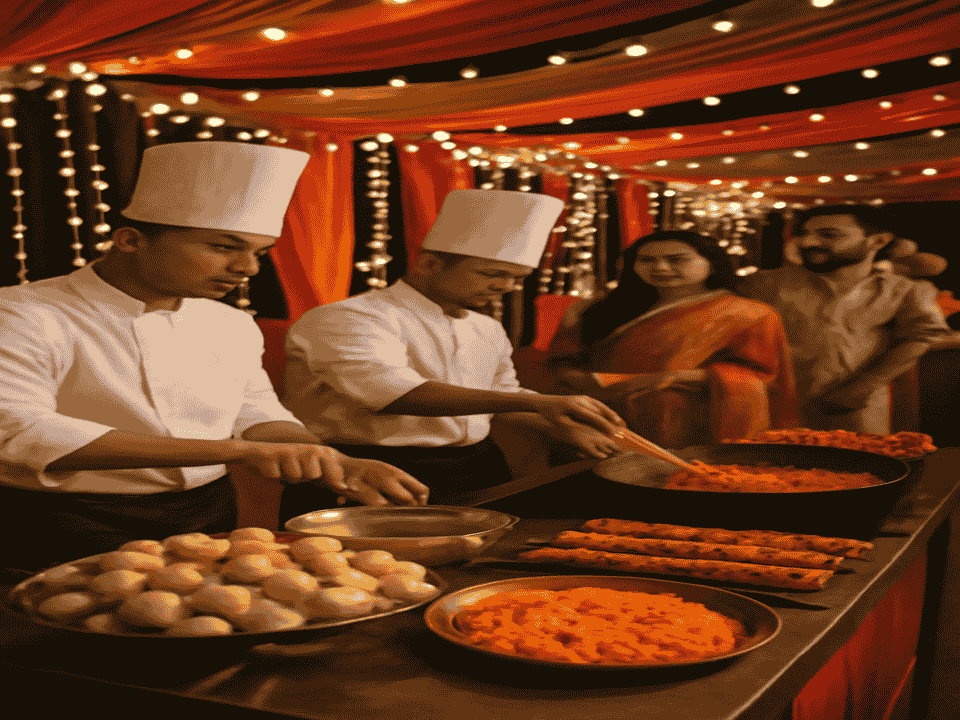
Planning Tips, Budgeting & Common Mistakes to Avoid in a Bengali Wedding Menu
Food is without a doubt the most important part of any Bengali wedding. A well-planned Bengali wedding menu can make the whole event better, and your guests will talk about it for months or even years. But choosing your favorite dishes is only the beginning of making the perfect Bengali wedding menu. There are a lot of things that every couple and their families should keep in mind, like picking the right caterer, staying on budget, and avoiding food disasters at the last minute.
This is a complete guide to planning the food for your Bengali wedding like a pro, with no stress and lots of flavor!
1. Set the limits: How Many Things? How Many People Are Coming?
The first thing you need to do is figure out how big your wedding will be:
How many functions are there?
Each event, like the Aiburobhaat, Gaye Holud, Wedding Night, Reception, and Post-Wedding Brunch, needs its own menu
2. Budget Smart: Food Takes 30–40% of Wedding Costs
On average, food and catering consume 30–40% of a wedding budget. Here’s how to manage it:
| Menu Element | Budget Strategy |
|---|---|
| High-end ingredients (like hilsa, jumbo prawns) | Use them selectively (1–2 dishes max) |
| Number of courses | Keep it elegant; too many dishes overwhelm guests and inflate costs |
| Seasonal produce | Choose vegetables and fruits in season for freshness and cost-effectiveness |
| Dessert section | Instead of 6 items, go for 3 high-quality sweets with variety |
| Fusion or exotic items | Limit global items to one section (e.g., starters or dessert) |
Pro Tip: Choose a reputable caterer with transparent costing and tasting sessions included.
3. A list of things to do before booking a caterer
It’s not just about the food when you hire a caterer; it’s also about the whole service. Before you sign a contract, make sure to check this list:
✅ Request a sample of the food
✅ Ask if they bring plates, silverware, and waitstaff
✅ Check how they handle live counters or hot service
Check to see if they can handle a lot of people (more than 300).
✅ Get recent reviews or references
✅ Ask for a full written breakdown of the menu
You should hire professionals to take care of your Bengali wedding food, not rush it.
4. Mistakes people make when planning their wedding menu (and how to avoid them)
Without foresight, even the best plans can go wrong. Here are some of the most common mistakes people make when making a Bengali wedding menu and how to avoid them:
Mistake 1: Putting too many things on the menu. Reality: Too many things make the food worse and confuse guests.
Solution: Limit each course to 4–5 main dishes. Make sure that each one is done right.
❌ Mistake 2: Not enough good vegetarian choices
The truth is that Bengali weddings sometimes leave out vegetarian guests.
Fix: Add at least four vegetarian main dishes that are well-made, such as one dal, one paneer or chhanar dish, and a rich sabzi.
❌ Mistake 3: Serving Food Too Late Reality: Guests get angry when food takes too long to arrive.
Fix: Tell your caterer to start serving dinner or a buffet right after the rituals are over. If you’re having a sit-down dinner, keep the snacks coming all the time.
❌ Mistake 4: Not thinking about the time of year
Reality: Mishti Doi doesn’t last long in the summer, and hilsa isn’t always available.
Fix: Pick foods that are perfect for the wedding season. For instance:
Winter: Pithas, Enchor, Shukto, and Pulao with thick gravies
Summer: Light fish curries, Aam Pora drinks, and fewer oily appetizers
❌ Mistake 5: Not paying attention to guests who aren’t Bengali
Truth: Not everyone knows what a Shukto is.
Add a “Universal Favorites” section with fried rice, chicken curry, gulab jamun, salad, and more
5. Different types of service: buffet, sit-down, and hybrid
The way you serve your Bengali wedding food affects both the experience and logistics.
| Style | Pros | Cons |
|---|---|---|
| Buffet | Guests choose their portions; efficient for large crowds | Can lead to queues; food may cool if left uncovered |
| Sit-Down | Elegant, personal, great for family-style events | Slower; needs more waitstaff and organization |
| Hybrid | Buffet mains, with table-served starters & desserts | Best balance, but needs planning and well-trained staff |
A modern favorite is buffet-style with live counters and table-served desserts — festive yet smooth.
6. Packaging and leftovers
Planning for leftovers is useful and appreciated. Ask your caterer about:
- Putting leftover food in boxes to give to family or friends
- Working with NGOs or food banks to give away extra food
- Giving guests dessert boxes to take home
This makes things more thoughtful and cuts down on waste, which is always a good thing!
7. Last Things to Do Before the Big Day
Here is a short list to help you make sure your Bengali wedding menu is perfect:
- Menu finished and printed out or put up at the venue
- All food allergies and dietary restrictions are noted
- Water, drinks, and appetizers are available 30 minutes before dinner.
- One person from the family or catering takes care of the live counters
- Extra rice, dal, and one vegetable in case of an emergency
- If needed, a separate area for the bride and groom to serve their guests
- Confirmed logistics for heating and cooling desserts
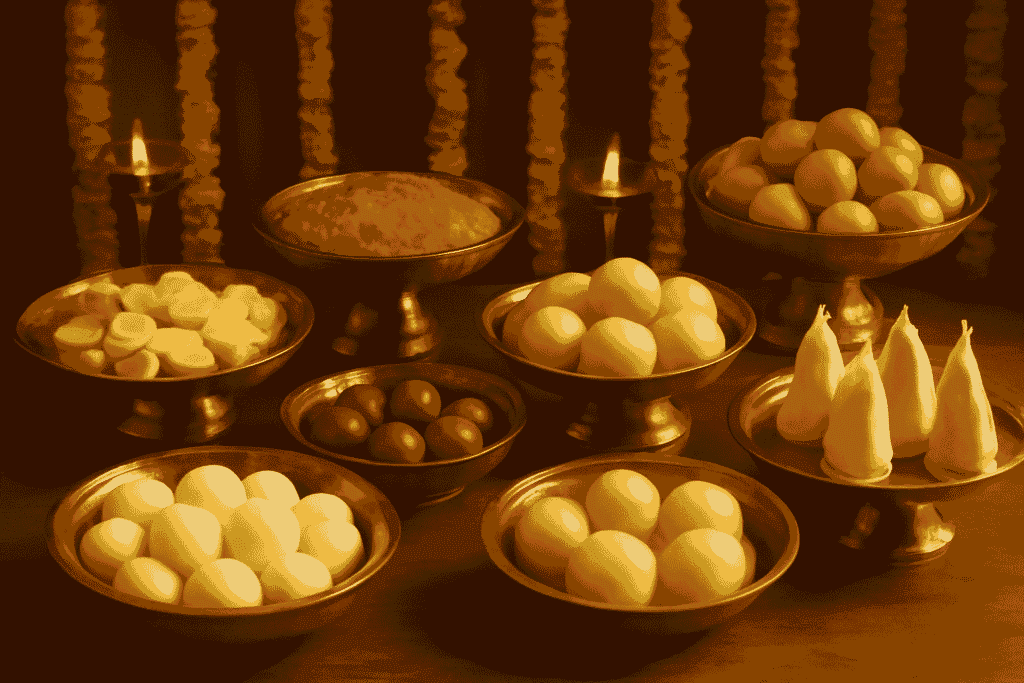
Final Thoughts, Trends & Keyword Optimization Summary
Making a Bengali wedding menu is an emotional, traditional, and creative process. Food isn’t just about feeding guests; it’s a way to tell stories. For example, a simple home-style Aiburobhaat or a grand multi-course wedding night feast. One that honors love, family, and community.
In this last part, let’s go over the main points, how Bengali wedding food is changing, and how this content uses your keywords in a good way.
Last Thoughts on Your Bengali Wedding Menu
- Food is a way to express feelings: In Bengali culture, food is a way to celebrate. Every dish on your Bengali wedding menu should make you feel good and proud, whether it’s a hot plate of Shorshe Ilish or a cold bowl of Mishti Doi.
- Everything is about balance: A great Bengali wedding food spread has a mix of old and new dishes, vegetarian and non-vegetarian options, and sweet and savory foods.
- Serve with Love: The way the food looks, when it’s served, and how warm it is are just as important as how it tastes. A simple Luchi can taste great when it’s hot and fresh with Cholar Dal and a smile.
- Guest Experience is Important: Think about what your guests like to eat and what they can eat. A wedding meal should taste good and include everyone.
- Don’t Overwhelm: More isn’t always better. Your wedding meal will really stand out if you choose the right food and arrange it well.
Trending Bengali Wedding Menu Ideas in 2025
Even in cultures that are very traditional, food trends change. This year, we are seeing some new things in the Bengali wedding menu:
- 1. Live counters with Bengali street food
Puchka stations with foam made from tamarind - Mango salsa and jhalmuri cones
- Telebhaja carts with different kinds of fritters
- 2. Bengali Fusion Food
Arancini with biryani (risotto balls with mutton stuffing) - Cheesecake with Gondhoraj
- Kasundi Slaw on a Chingri Taco
- 3. Dessert Bars with Activities
Make your own Pithe counter - Sandesh platter styling areas
- Frozen yogurt with Mishti Doi
4. Healthy Additions: Millet Pulao
- Luchi without gluten (yes, it’s happening!)
- Chhanar Dalna for vegans
- These new ideas don’t get rid of tradition; they give it a new look by mixing global trends with local love.
The Bengali wedding menu is very important to the culture because it shows how hospitable and festive Bengal is. All of the food, from appetizers to desserts, has a special meaning and shows the culture of Bengali families. The food is more than just a feast; it’s a way to honor guests and celebrate the holy union with warmth and flavor.
The Bengali wedding menu has changed over time to include things like fusion cuisine, live counters, and themed presentation. Even though traditional foods like shorshe ilish and kosha mangsho are still important, modern weddings often add foods from around the world and healthy options. This mix of old and new keeps the menu up to date while honoring cultural roots.
The Bengali wedding menu is very different from region to region. Families from East Bengal often have more fish-based dishes on their menus, like ilish or pabda. There are usually more expensive meat dishes and a wide range of sweets like sandesh and mishti doi at weddings in West Bengal. These local touches make each wedding meal special and very personal.

